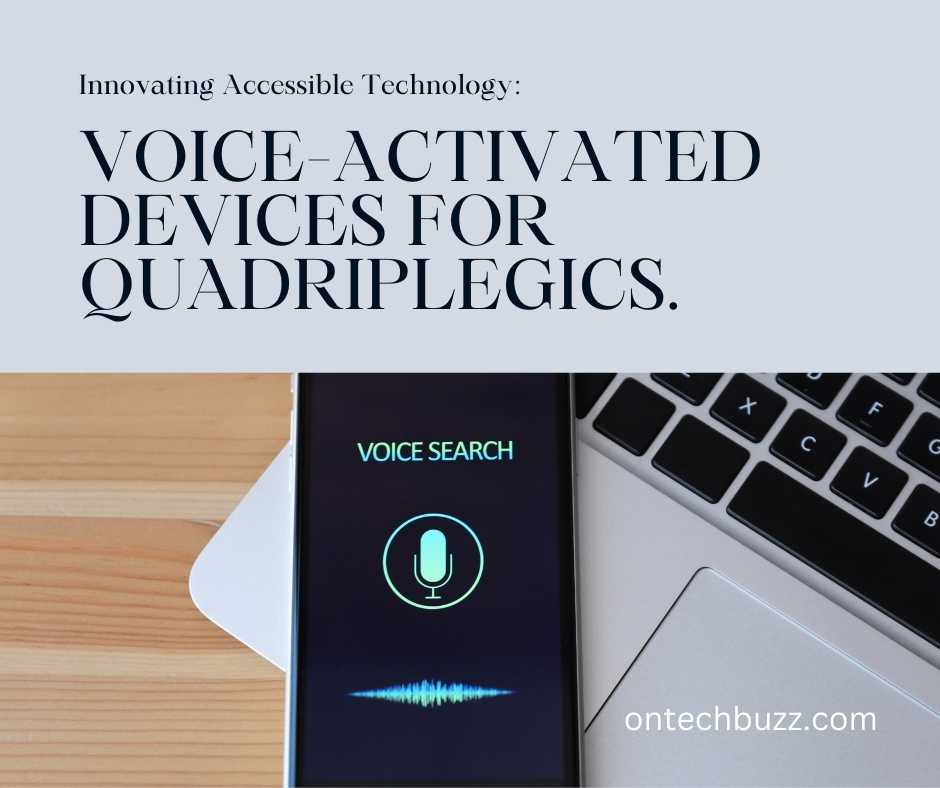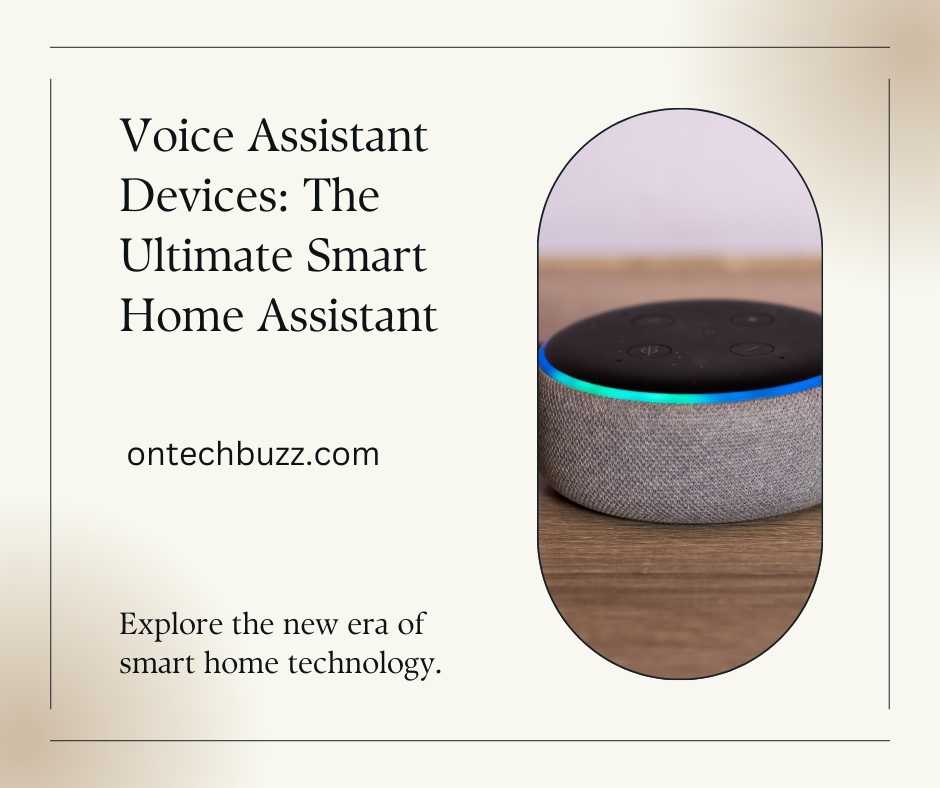
Learn about the empowering world of voice activated devices for quadriplegics. Explore cutting-edge solutions designed to enhance accessibility and independence. Find the perfect voice-controlled tools tailored for those with limited mobility at ontechbuzz.com
Voice activated devices provide essential support to quadriplegics for accessing technology and communicating with others. These innovative devices, including Amazon Echo, Google Home, Tecla-e app, and tongue-controlled wheelchairs, enable quadriplegics to control various important devices using voice commands and adaptive switches.
Additionally, these assistive tools facilitate independent living and improve the overall quality of life for individuals with quadriplegia. Assistive devices for quadriplegics, such as voice-activated technology and adaptive tools, play a crucial role in enhancing their daily lives. From controlling smartphones and wheelchairs to navigating computers and operating smart home systems, these devices offer newfound independence and accessibility.
Voice-activated assistants like Siri, Google Assistant, and Amazon Echo, along with eye-tracking systems and switch access, empower quadriplegics to interact with their environment and communicate effectively. These tools provide invaluable support, unlocking new possibilities and improving the overall well-being of individuals living with quadriplegia.

Credit: attoday.co.uk
Table of Contents
Voice Activated Devices For Quadriplegics
Voice activated devices have revolutionized the lives of quadriplegics by providing them with a newfound sense of independence and control over their surroundings. The emergence of advanced technological solutions has opened up a world of possibilities for individuals with limited mobility, allowing them to operate various devices and perform everyday tasks with unprecedented ease. In this article, we delve into the transformative impact of voice activated devices for quadriplegics, explore the different types of tools available, and examine real user experiences and case studies.
Understanding The Impact Of Voice Activated Devices On Quadriplegics
Voice activated devices for quadriplegics have significantly improved their quality of life by enabling them to perform tasks, control their environment, and communicate more effectively. This innovative technology has reduced their dependency on caregiver assistance and empowered them to lead more independent lives. By leveraging voice commands, individuals with quadriplegia can seamlessly operate a myriad of smart devices and access essential information, thereby enhancing their overall sense of autonomy.
Different Types Of Voice Activated Tools Available
Various types of voice activated tools are now accessible to quadriplegics, catering to a wide range of needs and preferences. Some of these devices include Amazon Echo, Google Home, Tecla-e, and tongue-controlled wheelchairs. Additionally, individuals can utilize smartphone apps that enable them to control their mobile devices through voice commands, offering them greater flexibility and convenience.
User Experiences And Case Studies
Real-life user experiences and case studies have demonstrated the profound impact of voice activated devices on the lives of quadriplegics. These individuals have expressed enhanced comfort, convenience, and freedom, as well as improved communication and productivity. By sharing these success stories, we aim to highlight the tangible benefits that voice activated devices bring to the quadriplegic community, shedding light on their positive impact on daily living and overall well-being.
Voice Activated Tools: Changing Lives

Voice activated devices have revolutionized the lives of individuals living with quadriplegia, providing them with the freedom and independence to carry out daily tasks that were once challenging or impossible. These assistive technologies have not only bridged the gap between disability and accessibility but also contributed significantly to self-reliance and empowerment.
How These Devices Bridge The Gap For Quadriplegics
Voice activated devices serve as a lifeline for quadriplegics, bridging the gap between their physical limitations and the technology-driven world around them. These devices facilitate communication, control of electronic devices, and access to information, empowering individuals to lead more connected and independent lives.
Contribution To Self-reliance And Empowerment
By enabling quadriplegics to control their environment using voice commands, these devices profoundly contribute to their self-reliance and empowerment. These individuals can manage smart home systems, control their wheelchairs, access the internet, and communicate with others using voice-activated tools, fostering a sense of autonomy and reducing dependency on others.
Comparison: Before And After The Adoption Of Voice Activated Devices
The adoption of voice activated devices marks a transformative shift in the lives of quadriplegics. Before the adoption of these devices, individuals often experienced limited control and access to the world around them. However, after integrating voice-activated tools into their daily routines, they experience newfound freedom, enhanced connectivity, and increased confidence in managing various aspects of their lives.
Selecting The Right Device
When it comes to selecting voice-activated devices for quadriplegics, it is crucial to consider essential features, customization and adaptability, and the top recommended devices that cater to the unique needs of quadriplegics.
Essential Features Of Voice-activated Devices For Quadriplegics
Given the challenges faced by quadriplegics, voice-activated devices should possess certain essential features to ensure ease of use and enable independent living. Some of the crucial features to consider include:
- Voice Recognition Accuracy: Ensuring precise and reliable recognition of voice commands is vital for seamless device interaction.
- Accessibility: Devices should offer accessibility features such as voice-activated controls, adaptive switches, and compatibility with assistive technologies.
- Compatibility: The ability to integrate with a wide range of smart home devices and applications, allowing quadriplegics to control their environment effectively.
- Reliability: Devices should exhibit consistent performance and minimal downtime to provide uninterrupted support to quadriplegics.
- Safety Features: Incorporating safety mechanisms to prevent unintentional activation and ensure user security.
Customization And Adaptability For Individual Needs
Each quadriplegic has unique requirements, and the ability to customize and adapt voice-activated devices to individual needs is paramount. Customization features may include:
- Personalized Voice Commands: Allowing users to create and modify voice commands based on their specific needs and preferences.
- Adaptive Interfaces: Providing adaptable interfaces to accommodate varying levels of motor function and offer tailored interaction options.
- Extended Compatibility: Supporting the integration of custom assistive technologies to address specific mobility and communication challenges.
- Flexible Configuration: Enabling the adjustment of sensitivity, response times, and other settings to suit individual capabilities.
Top Recommended Voice-activated Devices For Quadriplegics
Several voice-activated devices have garnered acclaim for their suitability in assisting individuals with quadriplegia. Some of the top recommended devices include:
- Amazon Echo: A versatile smart home hub with robust voice recognition and extensive compatibility with assistive technologies.
- Google Home: Offering seamless voice control for various smart home devices and convenient integration with accessibility tools.
- Tecla-e: A smartphone app specifically designed to facilitate online access for quadriplegic users through voice commands and adaptive controls.
- Dragon NaturallySpeaking: A renowned voice-recognition software that enables hands-free navigation of computers, providing essential independence for quadriplegics.
- Smart Assistive Switches: Customizable switches designed to empower quadriplegics by enabling voice-activated control of various devices and applications.
Integrating With Daily Life
For individuals living with quadriplegia, integrating voice activated devices into daily life has the potential to significantly enhance independence and accessibility. The seamless integration of these innovative technologies can empower quadriplegics to efficiently control various aspects of their environment, interact with digital devices, and carry out essential tasks without physical assistance.
Step-by-step Integration Of Voice Activated Devices Into Daily Routines
When incorporating voice activated devices into daily routines, it is essential to begin with a systematic approach to ensure smooth integration. Here is a step-by-step guide to integrate these devices into daily life:
- Identify specific tasks and areas where voice activation can be beneficial, such as controlling lights, adjusting room temperature, or using smart home appliances.
- Choose suitable voice activated devices that align with individual needs and preferences. Popular options include Amazon Echo, Google Home, or specific voice-controlled assistive technology.
- Customize voice commands based on personal requirements and ensure that the devices are seamlessly synchronized with other assistive technologies.
- Regularly practice and refine the use of voice commands to optimize efficiency and effectiveness in managing daily tasks.
Training For Effective Use Of Voice Commands
Effective utilization of voice commands requires dedicated training to maximize the potential of voice activated devices. Comprehensive training programs should encompass the following components:
- Understanding the functionalities and capabilities of the voice activated devices.
- Practicing voice command techniques for controlling different devices and executing specific tasks.
- Receiving guidance on optimizing voice recognition accuracy and troubleshooting common issues.
- Continuous support and coaching to adapt to new features and updates of voice activated technologies.
Overcoming Challenges And Troubleshooting Common Issues
While integrating voice activated devices, individuals may encounter challenges or technical issues which can hinder seamless usage. Here are common issues and strategies to overcome them:
| Common Issues | Troubleshooting Strategies |
|---|---|
| Low voice recognition accuracy. | Adjust microphone settings and retrain the voice recognition system for improved accuracy. |
| Difficulty in integrating with specific assistive devices. | Seek assistance from specialized support services or technical experts for compatibility solutions. |
| Complexity in managing multiple voice controlled devices. | Create customized voice command groups and utilize centralized voice control solutions where applicable. |
Sharing The Power Of Voice

Elevating Quadriplegic Empowerment Tools Through Collaboration
Voice-activated devices have become a game-changer for quadriplegics, enabling them to regain independence and autonomy. Through collaboration with technology experts, these empowerment tools have evolved to cater specifically to the unique needs of quadriplegics, providing innovative solutions to enhance their quality of life.
Educational Programs And Community Support For Quadriplegics
Education and community support play a crucial role in empowering quadriplegics to effectively utilize voice-activated devices. Educational programs dedicated to training individuals on the practical use of these devices are essential in equipping quadriplegics with the necessary skills to maximize their potential. Additionally, fostering a supportive community enhances the learning experience and provides valuable insights for continuous improvement in utilizing these transformative technologies.
Future Developments In Voice Activated Technology For Enhanced Accessibility
The future of voice-activated technology holds promising advancements for enhanced accessibility. With ongoing research and innovation, new developments are continually emerging to further improve the functionality and usability of these devices for quadriplegics. Innovations in voice recognition, artificial intelligence, and connectivity are paving the way for a more inclusive and accessible environment, ultimately enhancing the lives of individuals living with quadriplegia.
Frequently Asked Questions On Voice Activated Devices For Quadriplegics
What Is The New Quadriplegic Technology?
The new quadriplegic technology includes voice-activated devices, mind-reading exoskeletons, tongue-controlled wheelchairs, and eye-tracking systems. These devices enable quadriplegics to use smartphones, control their environment, and navigate computers using voice commands, eye movements, or head gestures. They offer greater independence and accessibility.
What Is The Best Assistive Device For Paraplegic Patient?
The best assistive devices for paraplegic patients include voice-activated technology, such as Amazon Echo and Google Home, adaptive switches, head-controlled wheelchairs, and smartphone apps like Tecla. These devices enable greater independence and accessibility for individuals with paraplegia.
How Do Quadriplegics Use A Phone?
Quadriplegics can use voice-activated technology like Amazon Echo or Google Home to operate phones. They can also utilize adaptive switches and head or eye-tracking devices. Additionally, apps like Tecla allow control using head movements or voice commands. These innovative technologies empower quadriplegics to interact with their phones independently.
What Are The Assistive Technology For Individual With Spinal Cord Injury?
Voice-activated devices and apps like Tecla-e and Dragon NaturallySpeaking help quadriplegic individuals access technology. They can also use smart home systems, pressure relief devices, and mobility aids such as adapted vehicles and hospital beds. These assistive technologies enable greater independence and accessibility for those with spinal cord injuries.
Conclusion
Innovative voice-activated technologies offer a lifeline for quadriplegics, enhancing their independence and connectivity. From smartphone apps to hands-free control systems, these assistive devices enable seamless interaction with essential devices. With continuous advancements, the future holds limitless possibilities, empowering individuals with disabilities to navigate their world with greater ease and autonomy.
2 thoughts on “Voice Activated Devices for Quadriplegics: Empowerment Tools”